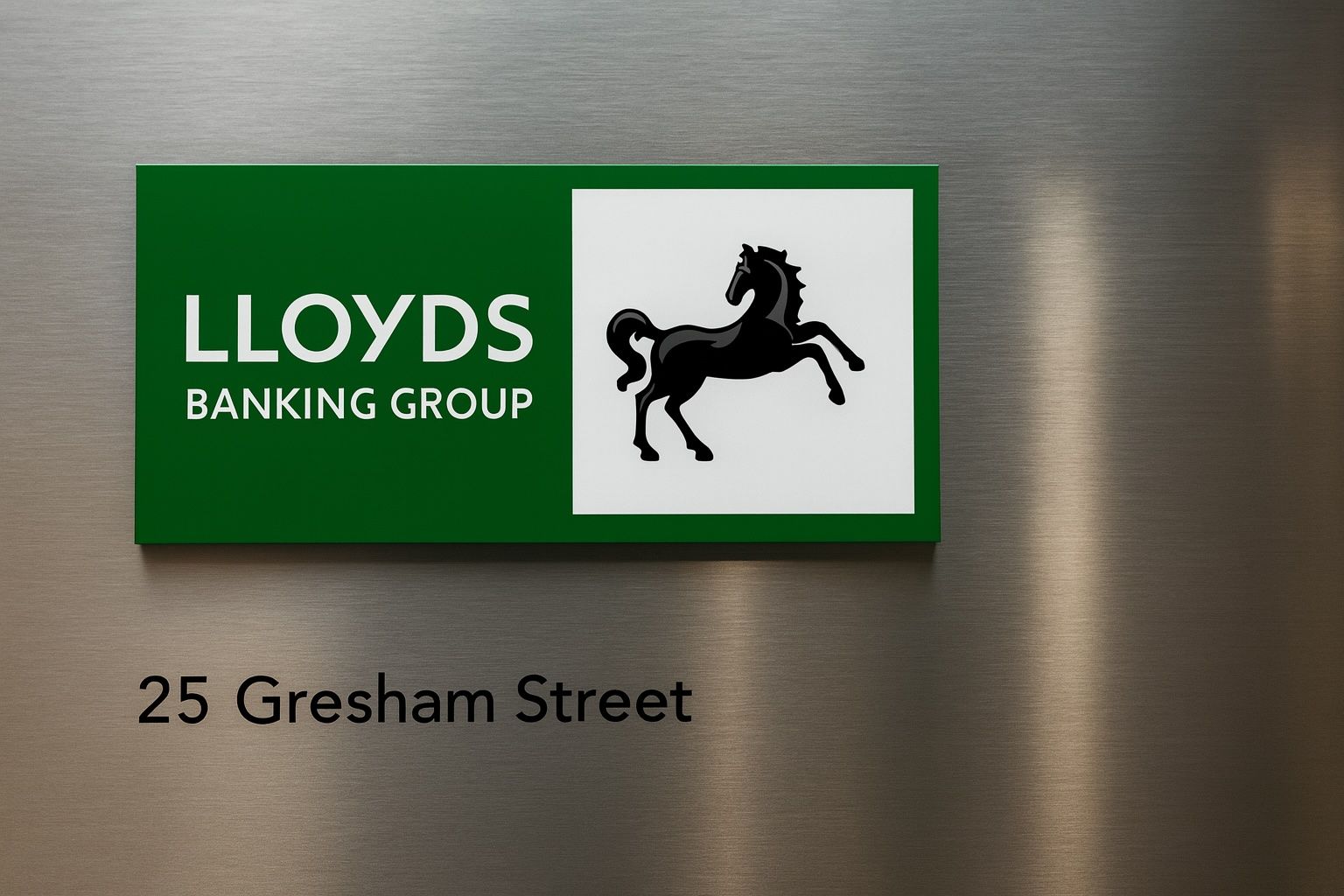- Current Price: ~85p (24 Oct 2025), near a 10‑year high [1] [2]. Year‑to‑date gain ~+50%, far outpacing the FTSE‑100 [3] [4].
- Q3 Profit: £1.17 bn (Jul–Sep 2025), down 36% y/y after an extra £800 m provision for car-finance mis-selling [5] [6]. Underlying profit (ex‑provision) slightly beat forecasts.
- Scandal Cost: Lloyds’ total motor‑finance scandal provision is now £1.95 bn [7] [8]. The FCA estimates the whole auto‑loan redress scheme could cost ~£11 bn across lenders. RBC analyst Benjamin Toms noted “some relief” that the extra £800m was “not a much larger number” [9] [10].
- Dividends & Buyback: Bank has resumed its dividend, yielding roughly 3.8–4% [11], and is executing a £2 bn buyback for 2025 [12]. Payouts (≈3.6p in 2025) are forecast to rise in 2026–27.
- Analyst Targets: City analysts’ 12‑month price target average ≈93p [13]. Broker forecasts range from ~95p (RBC) up to ~103p (Jefferies) [14]. At ~85p, LLOY trades at ~12–13× forward earnings, above peers [15] [16], suggesting much news is priced in.
Stock Rally and Current Price
Lloyds Banking Group (LSE: LLOY) shares have surged ~50% in 2025, hitting 10‑year highs. In mid‑Oct, LLOY traded ~86–87p – not seen since before the 2016 Brexit vote [17] [18]. By 24 Oct they were around 84–85p. The rally has far outpaced the FTSE‑100, making Lloyds one of the year’s standout performers [19] [20]. Analysts attribute the surge to very high UK interest rates boosting banks’ net interest margins and Lloyds’ dominant UK retail footprint. TS² (TechStock²) market analysis notes Lloyds “appears to be on solid footing… The share price is near its highest in a decade, supported by strong fundamentals” [21]. The bank’s H1 2025 results showed net interest income ~£6.7 bn (up ~5% y/y), underscoring these tailwinds [22] [23].
Investors also like Lloyds’ shareholder returns: dividends have resumed (current yield ~4%) and a £2bn+ buyback is underway [24] [25]. For example, Lloyds paid an interim dividend of 1.22p in Sept 2025. Broader UK growth has been steady, helping loan volumes, and Lloyds’ CET1 capital ratio (~13.8%) remains robust (above regulatory minima). CEO Charlie Nunn emphasized that “strong capital generation was supported by income growth, cost discipline and strong asset quality” through the first nine months of 2025, even after the one‑off charges [26].
However, the stock now trades at roughly 12–13× 2025 earnings [27] [28]. Some analysts caution that much of the good news is priced in [29] [30]. High valuations and upcoming risks (mortgage competition, credit growth) mean investors are taking profits – Lloyds’ gain over the last year (+36%) lags NatWest’s (+53%) but still dwarfs the FTSE (+15%) [31].
Third‑Quarter Results: Profit Plunge
Lloyds reported Q3 (Jul–Sep) pre‑tax profit £1.17 bn, down 36% from £1.8bn a year earlier [32] [33]. The decline was entirely due to the £800m extra charge for the motor‑finance mis‑selling scandal. Excluding that one‑off, underlying earnings met or beat expectations (Reuters: “broadly in line” with forecasts [34]). The results forced Lloyds to trim its full‑year return-on-equity guidance to ~12% (from 13.5%) [35].
Interactive Investor notes, “these quarterly results demonstrate that underlying progress remains strong” even with the provision overhang [36]. Indeed, Lloyds’ net interest income grew ~7% qoq in Q3 (aided by its structural hedge), and consumer lending remains healthy [37]. Deposits have stabilized and mortgages rose 4% YTD [38]. CEO Nunn stressed that, aside from the motor‑finance hit, Lloyds saw “strong capital generation” with rising income and tight costs [39].
Still, the profit drop was a shock to the market. Lloyds shares fell ~0.4% on 23 Oct as results sank in [40], reflecting concern that the scandal could recur. The Guardian reported Lloyds’ profit plunge and noted Lloyds is the UK’s biggest car‑finance provider (via Black Horse) and will pay the largest share of the FCA’s scheme [41] [42].
Motor‑Finance Scandal Provisions
The £2bn car‑finance scandal remains the overhang on Lloyds stock. The FCA’s proposed redress scheme (covering ~14.2 million contracts) is expected to cost lenders ~£11 bn [43]. Lloyds had already set aside £1.15 bn, then in mid‑Oct took an additional £800 m charge, bringing its total provision to £1.95 bn [44] [45]. This one‑off “material” top‑up was near the high end of analysts’ estimates (RBC had penciled £1.5–1.8 bn total [46]), which sparked a relief rally: LLOY stock actually rose ~1.6% on 13 Oct as investors noted the figure wasn’t worse [47].
Lloyds said it will challenge the FCA’s payout methodology, arguing the draft formula “is less closely linked to actual customer loss than anticipated” [48]. CEO Nunn and CFO William Chalmers are engaging regulators but have pledged to “compensate customers appropriately where harm has been suffered” [49]. However, Chalmers warned roughly 44% of car‑loan holders since 2007 might be paid, a “far in excess of what can be described as unfair” [50].
Despite the hit, Lloyds emphasizes its strong buffers. Its CET1 ratio (~13.8%) and profit base mean it can absorb the cost without cutting dividends or buybacks [51]. As one expert noted, the surprise wasn’t a bigger number – “there is some relief today that ‘material’ top‑up didn’t equate to a much larger number,” said RBC’s Benjamin Toms [52].
Analyst Outlook & Valuation
With the stock near £0.85, analysts have mixed views. Most predict modest further gains. The average 12‑month target is ~93p [53] (implying a single-digit upside). Recently, brokers have been bullish: RBC Capital raised its target to 95p, Jefferies to £1.03, and JPMorgan around 98p [54], expecting Lloyds’ earnings and return on equity to keep improving. These forecasts assume net interest margins stay near 3.1–3.3% [55] and cost cuts continue.
But skeptics warn much is priced in. TS² notes Lloyds now trades at ~13× forward earnings [56] – “pricier than many peers” – suggesting limited easy upside [57]. A Good Money Guide analysis similarly argues the strong rally may have pushed valuation too high. Loan impairment charges are rising (H1 2025 provisions £442m vs £100m a year prior [58]) and competition in mortgages is fierce [59].
On the positive side, Lloyds still offers an attractive yield (~4%) and a £2bn buyback will support EPS. It remains the UK’s retail banking leader, and fund managers have been buying in during the 2025 rally. As TS² summarized, Lloyds’ fundamentals – steady loan growth, tight costs, and strong capital – remain “strong,” even if the near‑term risks are significant [60].
Economic and Political Backdrop
Broader factors will shape Lloyds’ path. UK growth has steadied (IMF sees the UK as a G7 growth leader in 2025), which bodes well for consumer lending [61] [62]. High inflation has kept Bank of England rates at 5.25% (15‑year highs), which benefits banks’ margins. But the Bank is signalling future rate cuts, which could pressure margins next year.
Investors are also wary of policy changes. Ahead of the Autumn Budget, there is talk of higher bank levies. UBS economists say a “modest increase” in the bank tax surcharge (from 3% to 5%) is expected [63]. While officials suggest any windfall tax would be passed to customers, the uncertainty dampens sentiment. As RBC’s Toms put it, without clear “positive catalysts” (and with the motor provision looming), analysts were “struggling to get excited” about bank stocks [64].
Finally, global market jitters (e.g. recent US regional bank losses) have led to occasional pullbacks: on 17 Oct Lloyds briefly fell ~3% intraday but recovered by afternoon, underlining its relative strength [65].
Outlook: Cautious Optimism
In summary, Lloyds’ stock has delivered a stellar run, driven by higher interest income, returning profits to shareholders, and clarity on the scandal bill. For investors, it currently offers both capital growth and income. But the rally has priced in much of the good news. Going forward, watch for the UK economic signals (consumer health, inflation), the final shape of the motor‑loan scheme, and any budgetary moves on banks. As one TS² piece noted, Lloyds’ earnings per share could rise ~76% by 2027 (helped by buybacks) [66], but in the near term the market will be watching the numbers carefully.
Sources: Recent company results and market analyses [67] [68] [69] [70] [71] [72] [73], plus commentary from Reuters, The Guardian and CityAM [74] [75] [76].
References
1. ts2.tech, 2. ts2.tech, 3. ts2.tech, 4. ts2.tech, 5. www.reuters.com, 6. www.theguardian.com, 7. www.reuters.com, 8. ts2.tech, 9. www.reuters.com, 10. ts2.tech, 11. ts2.tech, 12. ts2.tech, 13. ts2.tech, 14. ts2.tech, 15. ts2.tech, 16. ts2.tech, 17. ts2.tech, 18. ts2.tech, 19. ts2.tech, 20. ts2.tech, 21. ts2.tech, 22. ts2.tech, 23. ts2.tech, 24. ts2.tech, 25. ts2.tech, 26. www.reuters.com, 27. ts2.tech, 28. ts2.tech, 29. ts2.tech, 30. ts2.tech, 31. www.ii.co.uk, 32. www.theguardian.com, 33. www.reuters.com, 34. www.reuters.com, 35. www.reuters.com, 36. www.ii.co.uk, 37. www.ii.co.uk, 38. www.ii.co.uk, 39. www.reuters.com, 40. www.reuters.com, 41. www.theguardian.com, 42. www.theguardian.com, 43. www.reuters.com, 44. www.reuters.com, 45. ts2.tech, 46. www.reuters.com, 47. ts2.tech, 48. ts2.tech, 49. www.theguardian.com, 50. www.theguardian.com, 51. ts2.tech, 52. www.reuters.com, 53. ts2.tech, 54. ts2.tech, 55. ts2.tech, 56. ts2.tech, 57. ts2.tech, 58. ts2.tech, 59. ts2.tech, 60. ts2.tech, 61. ts2.tech, 62. ts2.tech, 63. www.cityam.com, 64. www.cityam.com, 65. ts2.tech, 66. ts2.tech, 67. www.reuters.com, 68. www.theguardian.com, 69. www.reuters.com, 70. ts2.tech, 71. www.ii.co.uk, 72. ts2.tech, 73. ts2.tech, 74. www.reuters.com, 75. www.theguardian.com, 76. www.cityam.com







